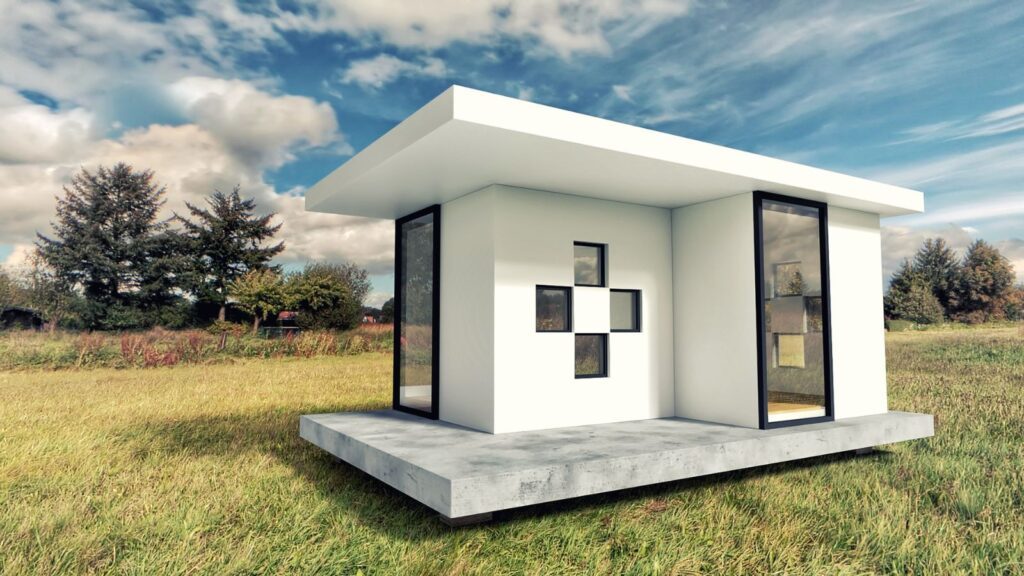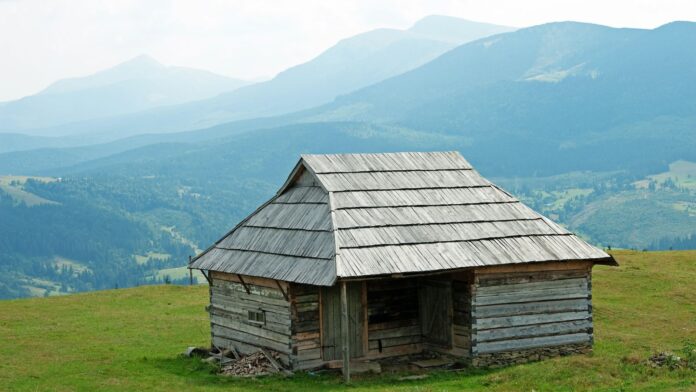Are you dreaming of embracing a simpler, more sustainable lifestyle by joining the tiny living movement? Welcome to “The Ultimate Guide to Building and Living in Tiny Home Huts!” In this comprehensive guide, we explore various types of tiny home huts, their benefits, and how you can design and build your own dream tiny house.
We also discuss practical tips for making the most of your compact living space and navigating legal considerations.
Key Takeaways
- Tiny home huts come in various types, including mobile houses on wheels, prefabricated huts, arched cabins and Tumbleweed Tiny House RVs. Each option offers unique advantages such as mobility and cost-effectiveness.
- Living in a tiny home hut provides several benefits – such as affordability, energy efficiency and minimal environmental footprint – that make it an attractive alternative to conventional housing. Additionally, this lifestyle encourages a simplified way of living, leading to greater mindfulness and appreciation for experiences over material possessions.
- When designing your own tiny home hut, it’s essential to consider factors like location suitability and design preferences. Building materials play a crucial role in constructing the structure of your tiny house frame; choosing high-quality hardware ensures secure structures while insulation materials help provide warmth or coolness depending on weather conditions. Other vital elements include roofing materials and exterior cladding options made from cedar shingles or corrugated metal for optimal durability.
- Additional resources are also available to guide individuals interested in building their own tiny homes successfully towards achieving affordable housing solutions that allow them to live sustainably with off-grid living options being more accessible than ever before thanks to technology advancements such as solar panels or composting toilets.”
Types Of Tiny Home Huts
There are several types of tiny home huts, including mobile houses on wheels, prefabricated huts, arched cabins, and Tumbleweed Tiny House RVs.
Mobile Tiny Houses On Wheels
Mobile tiny houses on wheels have become increasingly popular in recent years, providing a unique solution for those seeking off-grid living and ultimate flexibility. These homes are built on trailers, making them easily transportable to different locations, so you can fully embrace the minimalist lifestyle while staying mobile.
One notable example is the Tumbleweed Tiny House Company, which specializes in creating custom-built tiny houses on wheels with quality materials and designs catering to various individual needs.
In addition to being eco-friendly and energy-efficient, these micro-homes often feature clever space-saving solutions such as fold-out furniture and lofted sleeping areas.
Prefabricated Huts

Prefabricated huts are an excellent option for those who want to live in a tiny home hut without the hassle of building it themselves. These huts are typically pre-built off-site and delivered to your location, making them an ideal choice for those who have limited construction experience or time.
One advantage of prefabricated huts is that they are manufactured in a controlled environment, ensuring high-quality workmanship and materials. This means that they can withstand harsh weather conditions such as hurricanes and earthquakes better than traditional stick-built homes.
Furthermore, these huts can be designed to meet local building codes and zoning requirements, which makes it easier to obtain permits compared to building from scratch.
Arched Cabins
Arched Cabins are a popular option for those interested in tiny home living. These prefabricated huts come in a variety of sizes and can be constructed quickly and easily on site.
They are made from durable, galvanized steel, which makes them resistant to rust and pests.
One significant advantage of Arched Cabins is their versatility; they can be used as primary residences or as vacation homes, offices, workshops, or even storage sheds. Another benefit is that they offer an affordable housing solution that is both energy-efficient and environmentally friendly.
Tumbleweed Tiny House RVs
Tumbleweed Tiny House RVs are perfect for anyone who values mobility and wants to travel frequently without the hassle of packing and unpacking. These tiny houses on wheels are built with high-quality materials that make them durable and long-lasting, while also being lightweight enough to tow behind your vehicle.
One great benefit of Tumbleweed Tiny House RVs is their energy efficiency. With features such as solar panels, composting toilets, and tankless water heaters, they allow you to live off-grid without sacrificing modern conveniences.
Plus, since they’re classified as recreational vehicles (RVs), they often fall under different zoning regulations than traditional homes would.
Benefits Of Living In A Tiny Home Hut
Living in a tiny home hut offers many advantages, including affordability, energy efficiency, simplified lifestyle, mobility and minimal environmental footprint.
Affordability
Building and living in a tiny home hut can be incredibly affordable. With the average traditional home cost skyrocketing, more and more people are turning to compact living options as an alternative solution.
Tiny homes usually range from 100-500 square feet, making them significantly less expensive than larger properties. Additionally, smaller homes require fewer materials which directly reduces overall construction costs.
Not only do they require less material to build but they also reduce ongoing utility bills and maintenance costs; that’s because of their efficient designs focused on maximizing space while minimizing waste.
Moreover, many tiny house dwellers embrace DIY building techniques which further decrease labor expenses and put you directly in control of your budget for the entire project.
Energy Efficiency
One of the biggest benefits of living in a tiny home hut is its energy efficiency. Smaller homes require less energy to heat and cool, which can significantly reduce your monthly utility bills.
Additionally, many tiny housebuilders use eco-friendly materials like recycled insulation or solar panels, further reducing their carbon footprint. For example, using Energy Star-rated appliances and LED lighting can save homeowners up to 30% on their electricity bills each year.
In fact, according to research by The Tiny Life blog, the average tiny house uses only about 2-3 kilowatts of energy per day compared to the typical American household’s consumption rate of around 30 kWH per day.
Simplified Lifestyle
Living in a tiny home hut can bring about a simplified lifestyle, allowing you to focus on what truly matters. With less space and fewer possessions, you’ll find that your life becomes more intentional and organized.
In addition, living in a tiny home can lead to increased mindfulness and appreciation for the little things in life. A smaller space means that you’ll need to make conscious decisions about what items are most important to you, ensuring that everything serves a purpose.
This mindset carries over into other aspects of life as well, helping individuals prioritize experiences and relationships over material goods.
Mobility
Living in a tiny home hut offers the unique advantage of mobility. Unlike traditional homes, tiny huts can be easily moved from one location to another without much hassle.
You can park your mobile tiny house on wheels at an RV park, campsite or even on private land with permission.
The mobility factor is particularly appealing for individuals interested in off-grid living and sustainability as it allows them to explore new regions while minimizing their environmental footprint.
This makes tiny huts perfect for adventure-seekers who want to live sustainably and enjoy nature’s beauty without sacrificing comfort or security.
Designing And Building Your Tiny Home Hut
Learn how to choose the right location and design, what building materials and tools are needed, and steps involved in the construction process.
Choosing The Right Location And Design
One of the first steps in designing and building a tiny home hut is choosing the right location and design. When selecting a spot for your tiny home, consider factors such as zoning regulations, access to utilities, and proximity to community resources.
When it comes to designing your tiny home, there are countless possibilities based on personal preferences and needs. Consider factors such as space utilization, energy efficiency, natural lighting, and overall aesthetic appeal.
For example, if you’re someone who loves nature and wants plenty of sunlight in your space, incorporating large windows may be a great option.
Building Materials And Tools Needed
To build a tiny home hut, you will need various building materials and tools. One essential tool is a saw to cut the wood used in constructing your tiny house frame. High-quality hardware is also crucial for securing your structure together, as well as insulation materials to keep your small space warm or cool depending on the weather conditions.
Tools like power drills, hammers, screwdrivers, pliers, among others are necessary for any DIY project. It’s vital to select high-quality and durable building materials that can withstand harsh weather conditions if you plan to live off-grid on rugged terrains or remote areas with extreme climates.
Steps Involved In The Construction Process
Building a tiny home hut requires a lot of planning, preparation, and hard work. Once you’ve chosen the right location and design, it’s time to start with the construction process.
The first step is to lay the foundation or attach your house to an existing trailer or chassis if it’s a mobile tiny home. Next, you’ll need to frame your walls and roof using appropriate building materials like lumber, steel studs or SIPs (structural insulated panels).
One key aspect of tiny home construction is efficient use of space which helps maximize comfort levels within limited square footage. This can mean installing multi-functional furniture such as convertible sofas or tables with storage underneath them.
DIY options are also available here as some homeowners choose to build custom pieces themselves instead of buying pre-made items from stores.
Meeting Local Building Codes And Zoning Regulations
Before starting the construction process, it is important to research and meet local building codes and zoning regulations. This will ensure that your tiny home hut is legal and safe for living.
Building codes vary by location, so it’s important to check with your local government office or building department for specific requirements.
Zoning laws may also impact where you can build and live in a tiny home hut. Some areas may not allow tiny homes on wheels as permanent residences or may require them to be located in specific zones such as RV parks or backyard accessory dwelling units (ADUs).
Living In A Tiny Home Hut
Maximizing space is essential for comfortable living in tiny home huts, so consider multi-functional furniture such as foldable tables and beds that can be tucked away when not in use.
Space-saving Tips And Tricks
When living in a tiny home hut, maximizing space is key. There are many ingenious ways to create storage and functionality while still keeping everything organized and easily accessible.
Some great space-saving tips include using multi-functional furniture such as foldable tables that can double as workspace during the day and dining areas at night.
Other ideas include building custom cabinetry that fits your specific needs and opting for appliances that take up minimal counter space such as under-counter refrigerators or compact stovetops.
Additionally, incorporating clever design elements such as lofted sleeping areas or built-in seating with hidden storage compartments can effectively maximize every inch of available square footage in your tiny home hut.
Multi-functional Furniture Ideas
When it comes to living in a tiny home hut, every inch of space counts. That’s where multi-functional furniture comes in handy. Furniture such as a Murphy bed that folds down from the wall or a sofa with built-in storage can help save valuable floor space.
Other creative options include using an ottoman that also serves as extra seating and storage, or opting for a loft bed with integrated shelving underneath for clothing and other items.
With some ingenuity and creativity, even the smallest space can become functional and comfortable.
Essential Utilities And Systems
In order to live comfortably in a tiny home hut, it’s important to have access to essential utilities and systems. These include water, electricity, heating/cooling, waste disposal, and internet/cell service.
Many off-grid tiny homes rely on alternative sources of energy such as solar panels or wind turbines for electricity and propane or wood-burning stoves for heating. Additionally, composting toilets are a popular option for waste disposal in these homes.
It’s important to research local regulations and zoning laws before installing any utilities or systems in your tiny home hut.
Legal Considerations And Insurance Options
It’s important to consider the legal and insurance aspects of living in a tiny home hut. Zoning regulations vary by state and location, so it’s essential to research local codes before building or moving into a tiny home.
Some areas have specific minimum square footage requirements that must be met, which may affect the size of your tiny home. Additionally, insurance coverage can be challenging for tiny homes as they are not always covered by traditional homeowner policies.
When it comes to legal considerations, it’s also important to note that parking and utilities play a significant role in where you can place your tiny house.
Despite these challenges, many people who live in tiny homes find that the benefits outweigh any potential drawbacks.
Conclusion
In conclusion, this guide has covered everything you need to know about building and living in tiny home huts. From the different types of tiny homes available to the benefits of living small, designing and building your own tiny house, and even tips for living comfortably in a smaller space.
We hope that this comprehensive guide has provided you with valuable information and resources on how to start your own journey towards a simpler, more sustainable lifestyle.
Remember, there are many options out there when it comes to building or buying a tiny home hut that fits your needs and budget.
FAQs:
1. What are some benefits to living in a tiny home hut?
Living in a tiny home hut can provide financial freedom and environmental sustainability. They also offer a simpler, more minimalist way of living that allows for less clutter and greater flexibility.
2. How much does it cost to build a tiny home hut?
The cost of building a tiny home hut can vary greatly depending on the size, materials used, and location. However, it is generally much more affordable than traditional housing options.
3. Do I need any special permits or permissions to live in a tiny home hut?
It depends on your location and local regulations. Some areas allow for tiny homes as long as they meet certain requirements, while others may require additional permitting or zoning changes.
4. Can I customize my own design for my tiny home hut?
Yes! One great benefit of building your own tiny home is the ability to create a design that fits your specific needs and preferences, whether it be with unique furnishings or incorporating eco-friendly features like renewable energy sources or composting toilets.




